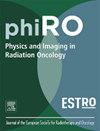Optimal timing of organs-at-risk-sparing adaptive radiation therapy for head-and-neck cancer under re-planning resource constraints
IF 3.4
Q2 ONCOLOGY
引用次数: 0
Abstract
Background and purpose
Prior work on adaptive organ-at-risk (OAR)-sparing radiation therapy has typically reported outcomes based on fixed-number or fixed-interval re-planning, which represent one-size-fits-all approaches and do not account for the variable progression of individual patients’ toxicities. The purpose of this study was to determine the personalized optimal timing of re-planning in adaptive OAR-sparing radiation therapy, considering limited re-planning resources, for patients with head and neck cancer (HNC).
Materials and methods
A novel Markov decision process (MDP) model was developed to determine optimal timing of re-planning based on the patient’s expected toxicity, characterized by normal tissue complication probability (NTCP), for four toxicities. The MDP parameters were derived from a dataset comprising 52 HNC patients treated between 2007 and 2013. Kernel density estimation was used to smooth the sample distributions. Optimal re-planning strategies were obtained when the permissible number of re-plans throughout the treatment was limited to 1, 2, and 3, respectively.
Results
The MDP (optimal) solution recommended re-planning when the difference between planned and actual NTCPs (ΔNTCP) was greater than or equal to 1%, 2%, 2%, and 4% at treatment fractions 10, 15, 20, and 25, respectively, exhibiting a temporally increasing pattern. The ΔNTCP thresholds remained constant across the number of re-planning allowances (1, 2, and 3).
Conclusion
In limited-resource settings that impeded high-frequency adaptations, ΔNTCP thresholds obtained from an MDP model could derive optimal timing of re-planning to minimize the likelihood of treatment toxicities.

重新规划资源约束下保留高危器官的头颈癌适应性放射治疗的最佳时机
背景和目的先前关于适应性器官风险(OAR)保留放射治疗的研究通常报告的结果是基于固定数量或固定间隔的重新规划,这代表了一刀切的方法,并没有考虑到个体患者毒性的可变进展。本研究的目的是考虑到头颈癌(HNC)患者有限的重新规划资源,确定适应性保留卵巢放射治疗重新规划的个性化最佳时机。材料和方法建立了一种新的马尔可夫决策过程(MDP)模型,用于根据患者的预期毒性(以正常组织并发症概率(NTCP)为特征)确定四种毒性的最佳重新计划时机。MDP参数来自2007年至2013年期间接受治疗的52例HNC患者的数据集。采用核密度估计平滑样本分布。当整个治疗过程中允许的重新规划次数分别限制在1次、2次和3次时,获得了最优的重新规划策略。结果当计划与实际nntcp (ΔNTCP)在处理分数10、15、20和25分别大于或等于1%、2%、2%和4%时,MDP(最优)溶液建议重新规划。ΔNTCP阈值在重新计划允许数(1、2和3)中保持不变。结论在资源有限的环境中,阻碍高频适应,从MDP模型中获得的ΔNTCP阈值可以得出重新计划的最佳时机,以最大限度地减少治疗毒性的可能性。
本文章由计算机程序翻译,如有差异,请以英文原文为准。
求助全文
约1分钟内获得全文
求助全文
来源期刊

Physics and Imaging in Radiation Oncology
Physics and Astronomy-Radiation
CiteScore
5.30
自引率
18.90%
发文量
93
审稿时长
6 weeks
 求助内容:
求助内容: 应助结果提醒方式:
应助结果提醒方式:


